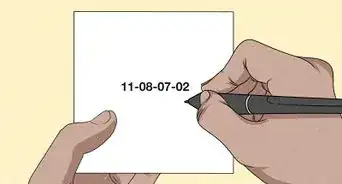This article was co-authored by Shawn Fago. Shawn Fago is a Master Locksmith and the Founder of Noble Locksmith, a nationwide locksmith company based in San Diego, California. With over seven years of experience, he provides commercial, residential, and automotive locksmith services to customers. Shawn attended California State University, Fullerton.
This article has been viewed 174,973 times.
Hiring a locksmith to remove a broken key can cost you hundreds of dollars. If you have a broken key in the lock of your car or house, before you resort to calling a professional, you can try to remove the key yourself. Usually, you can get out a broken key in just a few minutes. You may be surprised how easy it is to do.
Steps
Hooking a Key with an Extractor Tool
-
1Flush the lock with a spray lubricant. Place the straw attachment on the spray nozzle. Press the other end of the straw attachment against the opening of the lock.
- Select a silicone spray. Silicone lubricant will help the key slide out easily, and since it is water resistant it will help to protect your lock against rust.[1]
- You can also try to use a graphite powder. It can help to lubricate without gumming up the lock.
-
2Align the cylinder. The cylinder will need to be in a locked or unlocked position to be able to extract the key fragment from the door. If you try to remove any key when the key is in between states it will stay stuck in the lock.
- Use needle nose pliers to reach inside the cylinder. Turn the cylinder until the door is locked or unlocked.
Advertisement -
3Insert the broken handle portion of the key as a guide. Slide the handle portion of the key into the lock until it reaches the broken segment. You will want to see where the large groove on the side of the key is located. This is the best spot to insert your extractor tool.
-
4Select your extractor tool. Key extractor tools are generally sold in a set with a variety of different key hooks and spiral extractors. You can buy them online or at any hardware store. The key hooks look like miniature harpoons, with long, thin rods and can have a variety of hook shapes on the end. Spiral extractors are thin, bendable metal rods with tiny hooks all along the length. While many of the tools might work for a number of different keys, it may take some trial and error to find the tool that best fits your lock and grips your key fragment.
- Start with the small hook tool. The small hooks on extractor tools can usually grab the majority of key types and shapes.
-
5Slide the extractor tool or tools into the lock. The hook should be facing upward to easily hook the teeth of the key. Direct the tool so that it slides in along the groove on the side of the key.
-
6Twist the extractor tool and pull. Once the extractor tool is in the lock, turn the tool toward the key slightly. Then pull the tool back while pressing the handle end away from the lock. This will press the hook against the key and help slide it out of the lock. Keep trying until the hook on the tool catches one of the teeth and you are able to pull the partial key free.[2]
- If using spiral style extractor tools the same rule methods apply. However, instead of twisting a small amount, you will want to spin the handle several times before pulling the tool straight back to remove the key fragment.
- You can try using an additional extractor tool on the other side of the key at the same time. Slide the key in the same way and pull the tools back and with slight pressure in the opposite direction to help grip the key between the tools.
- If the key comes part of the way out, use a pair of needle-nose pliers to grip the exposed portion and finish removing it. You want to be sure you don't accidentally knock it back into the lock.
Making a Saw Blade Extractor
-
1Break off one end of a coping saw blade. Coping saw blades are made of a thin, brittle metal and will snap easily when bent. Snapping off one end will allow the blade to fit into the lock.
- Check the angle of the teeth. Break off the end of the blade which the blade teeth are angled away.
- If you don't have a coping saw blade handy you can try other items around your house. Give anything that is a long, thin, rigid, and cylindrical a shot. For example, you can try a barbeque skewer or a bicycle spoke if you have access to them. Usually, such methods have a very low probability of success, especially if the key is wedged deep in the lock.
-
2Cover the other end of the blade with duct tape. Wrap several inches on the unbroken end with several layers of duct tape. If the blade teeth still poke through the duct tape, simply add another layer or two.
-
3Flush the lock with a spray lubricant. Use the spray nozzle and straw attachment and flood the cylinder with a coating of a lubricating silicone spray. Wipe up any excess spray that comes back out of the lock cylinder.
-
4Slide the coping saw blade in the cylinder alongside the key. Place the broken end of the coping saw blade into the lock cylinder with the teeth pointed upwards. Wiggle the handle end until the blade squeezes in next to the key.
- If you are trying to remove a car key that has teeth on both sides of the key, you can slide the saw blade in with the teeth up or down.[3] If you're not having luck gripping one side of the key, turn the blade around and try the other.
-
5Turn the duct-taped blade handle and pull. Twist the blade about a quarter turn toward the key, then pull the blade out and slightly toward the side away from the lock. Repeat this action several times until the blade successfully grips the key.
- If the key comes partially out, just grip the end with needle-nose pliers and finish removing the key the rest of the way.
Community Q&A
-
QuestionHow do you remove the core on a lockset? A key snapped off, and I can't get it out through all the conventional methods.
 Glenn LetteerCommunity AnswerThis question can't be answered without knowing exactly which type of lock the key is broken off in.
Glenn LetteerCommunity AnswerThis question can't be answered without knowing exactly which type of lock the key is broken off in.
Things You'll Need =
- Lubricant spray
- Needle nose pliers
- Lock extractor tool or coping saw blade
References
About This Article
To remove a broken key, start by spraying a silicon spray into the lock, which will lubricate it and make it easier for the broken key to slide out. Then, use a pair of needle nosed pliers to twist the cylinder so the lock is either locked or unlocked, since the key part won’t come out if it’s halfway between the 2 positions. Next, select an extractor tool from your set, which you can buy at a hardware store, and slide it into the lock with the hook facing upwards. Try to locate the groove on the side of the broken key, then twist your tool towards the key. Gradually pull the tool out, which will hopefully cause one of the hooks to catch on the broken key’s teeth and pull it out. Remember that you may have to try several extraction tools, since they are all made differently and will perform better depending on the type of lock you have. For tips on how to make your own extracting tool, read on!







































































